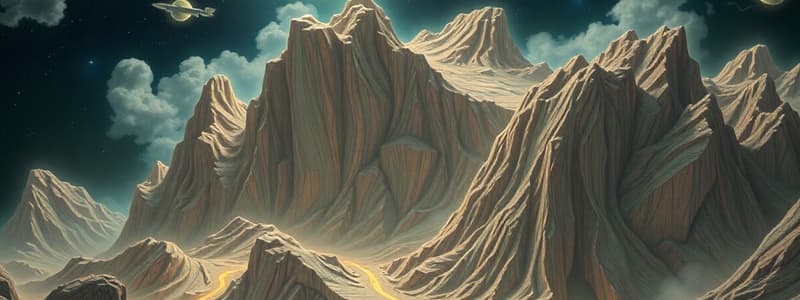Podcast
Questions and Answers
What type of fault occurs when two blocks of crust slide past each other horizontally?
What type of fault occurs when two blocks of crust slide past each other horizontally?
- Reverse fault
- Strike-slip fault (correct)
- Thrust fault
- Normal fault
What is the primary gas found in the Earth's atmosphere?
What is the primary gas found in the Earth's atmosphere?
- Nitrogen (correct)
- Carbon Dioxide
- Oxygen
- Hydrogen
What do we call the process when molten rock cools and solidifies?
What do we call the process when molten rock cools and solidifies?
- Metamorphism
- Crystallization or Solidification (correct)
- Igneous intrusion
- Magma formation
What layer of the Earth is responsible for generating the planet's magnetic field?
What layer of the Earth is responsible for generating the planet's magnetic field?
What is the term for the slow movement of continents over Earth’s surface?
What is the term for the slow movement of continents over Earth’s surface?
What is the term for a reaction that releases energy into its surroundings?
What is the term for a reaction that releases energy into its surroundings?
Which scientist is known for the development of the theory of plate tectonics?
Which scientist is known for the development of the theory of plate tectonics?
What is the lightest element in the periodic table?
What is the lightest element in the periodic table?
Which element has the highest atomic number that naturally occurs?
Which element has the highest atomic number that naturally occurs?
What is the primary component of Earth's atmosphere?
What is the primary component of Earth's atmosphere?
Flashcards are hidden until you start studying
Study Notes
Earth Science
- Rocks: Naturally occurring solid substances composed of one or more minerals.
- Strike-slip fault: A fault where two blocks of crust slide past each other horizontally.
- Troposphere: The layer of Earth's atmosphere where weather occurs.
- Crystallization or Solidification: The process of molten rock cooling and solidifying.
- Continental drift: The slow movement of continents over Earth's surface.
- Nitrogen: The primary gas found in the Earth's atmosphere.
- Plate tectonics: The movement of the Earth's plates on its surface.
- Magma: Molten rock below the Earth's surface.
- Outer core: The layer of the Earth responsible for generating its magnetic field.
- Igneous rock: Rock formed from the cooling and solidification of lava on the Earth's surface.
- Convection currents: The primary force that drives the movement of tectonic plates.
- Evaporation: The process of liquid water transforming into water vapor.
- Unconformity or contact: The boundary between two different rock layers.
- Fault: A fracture in the Earth's crust along which movement has occurred.
- Metamorphic rock: Rock formed through the process of metamorphism.
General Chemistry
- Sodium: Symbol Na
- Nitrogen: The most abundant gas in Earth's atmosphere.
- Covalent bond: A bond involving the sharing of electron pairs between atoms.
- pH scale: Measures the acidity or basicity of a solution.
- Pascal (Pa): The SI unit of measurement for pressure.
- Carbon dioxide: Chemical formula CO₂
- Carbon: Atomic number 6
- Ammonia: Chemical formula NH₃
- Endothermic reaction: A reaction that absorbs energy from its surroundings.
- Chlorine: Symbol Cl
- Condensation: The process of a gas turning into a liquid.
- Mole (mol): The SI unit used to measure the amount of substance.
Scientists and Space
- James Hutton: Considered the father of modern geology.
- Alfred Wegener: Proposed the theory of continental drift.
- Oxygen: The most abundant element in the Earth's crust.
- Mercury: The closest planet to the Sun.
- Yuri Gagarin: The first human to travel into space.
- Isaac Newton: Developed the law of universal gravitation.
- Jupiter: The largest planet in the solar system.
- Stratosphere: The layer of the atmosphere containing the ozone layer.
- Milky Way: The galaxy containing our solar system.
- Neil Armstrong: The first person to walk on the Moon.
- Dmitri Mendeleev: Created the periodic table.
- Marie Curie: Discovered the elements polonium and radium.
- Hydrogen: The most abundant gas in the universe.
- Niels Bohr: Proposed the model of the atom where electrons orbit the nucleus.
- Oganesson (Og): The element with the highest atomic number, its symbol is Og.
Studying That Suits You
Use AI to generate personalized quizzes and flashcards to suit your learning preferences.




